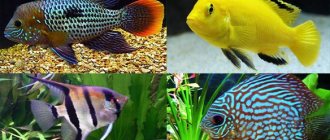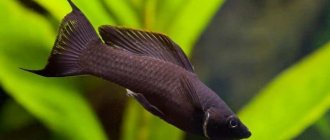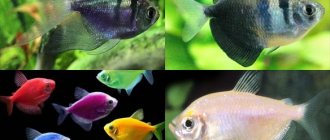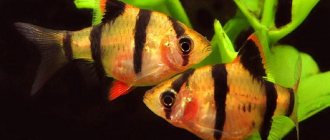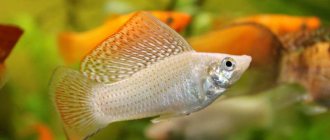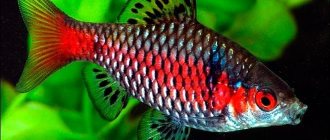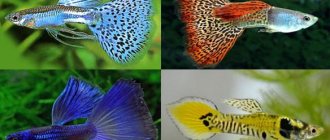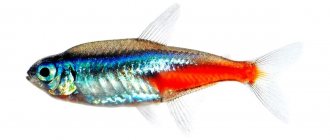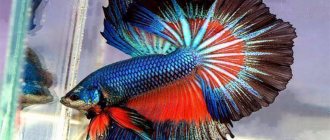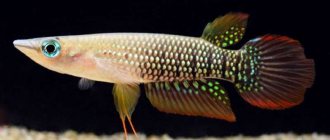Aquarium angelfish fish from the Cichlid family are charming inhabitants of artificial reservoirs, which are loved by aquarists not only for their external beauty and unpretentiousness. The main quality due to which angelfish has gained popularity is considered to be the fish’s ability to adapt to different living conditions and thrive in captivity for many years. However, aquarists interested in how long angelfish live in captivity should know that these fish are susceptible to many ailments. It is the diseases of the angelfish that cause the life of pets to suddenly end, so every holder of these fish should know the signs and methods of treating ailments.
Aquarium fish angelfish photo and description
Angelfish are the most common aquarium fish of the cichlid family, which are not only very beautiful, but also have unusual behavior that distinguishes them from others. There are three types of angelfish:
- The common angelfish has a classic body shape of a silvery color with four transverse stripes;
- Angelfish altum or tall-bodied, characterized by an elongated body - some grow up to 30 cm in height;
- Leopold's angelfish is a small species with an aggressive disposition.
- golden green, smoky, striped, black,
- two-color (bicolor);
- tricolor (Koi).
- lace;
- zebra;
- train or veil;
- black;
- gold;
- blue;
- marble;
- Red Devil;
- pearl or diamond;
- chocolate;
- white;
- Pinoy (Pinoy Zebra);
- Dantum Albino.
Aquarium fish Angelfish are not very whimsical, slow and graceful. They are very curious by nature and will watch with interest what is happening in the aquarium. They have a developed intellect and treat their offspring with care. If you walk into a room, they will certainly react to you.
Table of basic parameters of maintenance, care and nutrition:
| What should be the volume of an aquarium for Angelfish? | from 100 liters for a flock from 150 liters |
| What should be the temperature in the aquarium for Angelfish? | from +25-28° C |
| What pH should be in the aquarium? | from 5.5-7.5 pH |
| What should be the hardness of the water in the aquarium? | from 5-15° dH |
| What should be the substrate for an aquarium? | small pebbles or coarse sand suitable for living plantings |
| What kind of lighting should be in the aquarium? | moderate and daylight hours at least 12 hours |
| What should be the movement of water in the aquarium? | moderate |
| Maximum fish size | length up to 15 cm. Height from 26-30 cm (a lot depends on the volume of the aquarium) |
| What does aquarium fish eat? | almost any live food: bloodworms, adult brine shrimp, coretra, tubifex and specialized dry food |
| Type of aquarium fish | peaceful, but small fish and shrimp can become food for them |
| Who is compatible with in an aquarium? | compatible with all peaceful ones that do not fit in the mouth |
| Lifespan of an angelfish | in aquariums they live up to about 10 years, but with proper care up to 20 years |
Living in the wild
Angelfish is a freshwater tropical fish. The fish prefers slow-moving waters in South America: in the central basin of the Amazon River and its tributaries in Peru, Brazil and Colombia. In particular, the Ucayali River in Peru, the Oyapoc River in French Guiana, the Essequibo River in Guyana, the Solimões, Amapá and Amazon Rivers in Brazil. It is found in swamps or flooded lands where the vegetation is dense and the water is clear or cloudy. Water parameters vary from pH 6.0 to 7.0, water hardness from 3 to 10 °dH, and water temperature ranges from 26 to 30 °C.
In the wild, the fish live in densely planted areas where they feed on juvenile fish, insects, invertebrates and plants. They prefer ponds and rivers with slow flows and dense vegetation. The reservoirs in which angelfish live are characterized by warm, soft and slightly acidic water.
The flattened shape of the body allows them to easily maneuver among thickets of underwater plants, and the vertical dark stripes make them less noticeable to predators. In nature, fish usually gather in small schools.
How to care for Angelfish in an aquarium at home
Considering the size of this aquarium fish , to keep it you need to purchase a spacious aquarium - at least 100 liters, but if you keep a flock, then the aquarium should be 150 liters or more. It is necessary that there is enough space for free swimming.
Contents Angelfish cannot be called complex. Considering that these are tropical fish, you need to maintain a water temperature of 25-28° C. Optimal acidity is approximately 5.5-7.5 pH, hardness is 5-15° dH. They live only in aquariums with aeration and filtration. You also need to turn on the compressor twice a day for 20-30 minutes and change the settled water weekly, in a volume of 30%. They like moderate lighting, as they are shy when bright lights are turned on. Thickets of Vallisneria will create an imitation of the natural habitat. Angelfish do not need shelter.
History of appearance
The first information about the fish can be found in 1823 in the work of the German scientist Schultz. It got its name thanks to the Australian zoologist Heckel in 1840. European residents were able to get acquainted with it only in 1920 and begin to successfully breed it at home; before that time, all imported representatives of the species died. The angelfish came to the United States in 1930.
At the beginning of the twentieth century, almost no one could figure out how to breed these fish, so they were considered very valuable and rare. For the first time in 1914, in Hamburg, it was possible to provoke their spawning by accidentally increasing the water temperature in the aquarium to 32 degrees.
What to feed Angelfish
Angelfish do not require special nutrition. They perfectly consume almost any live food: bloodworms, adult brine shrimp, coretra, tubifex.
It is better to feed angelfish with frozen food, but the food must be brought to room temperature before feeding. Finely chopped ground beef or seafood, specialized dry food, which can be purchased at any pet store, are also suitable.
It is better to feed the fish 2-3 times a day little by little, while making sure that the food is eaten within 1-2 minutes, otherwise overfeeding may occur, which will worsen the health or even contribute to the death of the Angelfish. It is also useful to give your pets “fasting days” once a week - feed them only plant foods.
Feeding
Fish prefer to feed on the surface of the water, but without any problems they take food in the middle layers of the aquarium and lift it from the bottom.
What to feed? Angelfish are omnivores; they eat any type of food in an aquarium: live, frozen and artificial.
The basis of feeding can be high-quality flakes, and additionally give live and frozen food: tubifex, bloodworms, brine shrimp, and coretra. It is important to know two things, they are gluttons and cannot be overfed, no matter how much they ask.
And give bloodworms very carefully, and it is better to refuse it altogether. A slight overfeeding of bloodworms, and their intestines begin to bloat, so much so that pink bubbles stick out from the anal bladder.
It is much safer to feed with artificial food, since it is now of high quality.
How to distinguish a male Angelfish from a female
It is sometimes difficult to distinguish the sex of a given fish and is only possible when they become sexually mature - at 8-12 months. When buying young animals, you clearly cannot distinguish a male from a female, but the larger ones will probably turn out to be males.
The main distinguishing feature is that males have a fatty bump on their forehead, while female Angelfish do not. Also, in pairs, males are more active, but this is not a clear distinguishing feature, because sometimes females also imitate the behavior of the male.
Prevention
All diseases of aquarium fish are directly related to the conditions of detention. Angelfish are considered the most unpretentious and peaceful cichlids, and to maintain their health, it is recommended to adhere to the rules of keeping.
The conditions of detention are as follows:
The first step is to buy a large aquarium. For one pair of angelfish, a container with a volume of 100 liters is required, since animals love space, they grow quite large and can reach a height of 25 cm, including fins. Thus, the height of the aquarium is from 50 cm. In nature, angelfish live in flocks, but do not forget that they are territorial cichlids and two males can quarrel with each other not only for the female’s attention, but also for territory. Many diseases are associated with poor water quality. Therefore, you need to purchase a powerful filter, but at the same time regulate the water output, making it moderate. Angelfish prefer warm conditions, so the temperature of the water should be in the range from +26 to +28 degrees. If the water is +25C, then the reproduction process multiplies; if the indicator drops below, then the development of diseases begins. Once a week, do a water change - 30% of the total volume. Fish like to spend most of their time in shelters, so it doesn’t hurt to plant the aquarium with plants, place driftwood and other decorations. It is not recommended to use bright lighting, as the fish may get scared. It is worth choosing suitable lighting, taking into account the comfort of the inhabitants and plants. The fish are unpretentious in food. Therefore, they can be given both dry food and live, frozen food.
It is important to consider that angelfish are quite voracious and should be limited in their food intake.
May your angelfish be healthy!
If you follow these recommendations, you will not need to take other preventive measures, and the fish will grow healthy and active.
How do angelfish reproduce?
Angelfish form a monogamous pair and are faithful to their partner. They can spawn directly in the aquarium. When a pair of Angelfish plans to reproduce, they stay together, drive away other fish and clean the place they have chosen for spawning. They spawn every 7-10 weeks. In this case, the female lays several hundred eggs on leaves, pieces of driftwood, and even on the glass of the aquarium, after which the male fertilizes them. Next, larvae appear, which after some time become fry.
In addition to all their advantages, Angelfish are also caring parents who not only look after their eggs, but also the hatched fry.
Incubation period
For successful reproduction of fish, feeding and housing conditions must be observed. In the spawning tank, the offspring will be completely safe, the fish will be able to calmly prepare for reproduction after forming a pair. The main recommendation is to reduce the water hardness level if possible - the softer it is, the faster spawning will occur.
In most cases, angelfish spawn at the age of 1 year. The process assumes the absence of any irritants. The fish must be fed and protected from excessive attention. You can even cover the walls of the aquarium with paper to eliminate stressful situations.
Spawning can be considered to have begun if the female has a clearly visible, rounded abdomen. In this case, the male will be active, swim after her, and try to drive her into a place prepared for eggs. Peculiarities in the behavior of the male are also manifested in the fact that he begins to intensively clear the territory and protect it.
In most cases, spawning processes take place in the late afternoon, after the intensity of daylight decreases. The eggs are laid for about 1.5 hours, after which the male performs fertilization. After this, you can move the eggs to another aquarium so that spawning occurs again. The pregnancy of an angelfish lasts about 10-20 days.
Methylene blue is an excellent means of preventing infection of eggs.
The conditions that must be created for the successful development of eggs deserve attention. It is necessary to avoid the negative impact of fungal infection. To do this, it is recommended to add a little methylene blue to the water. If the eggs are moved to a separate place immediately after the process of fertilization, then care must be taken to ensure that their location is away from the aerator - at least 5 cm. This is necessary in order to avoid the entry of air bubbles. At the same time, care should be taken not to interrupt the process of washing the eggs with a small stream of water. The lighting of the aquarium is set specially - it should be moderate, but continuous.
During the development of eggs, constant monitoring is required. The following actions must be taken:
- remove whitened eggs from the clutch - this should be done with a needle or tweezers;
- regulate the water temperature - sudden changes in values should not be allowed, otherwise the eggs will die;
- Make sure that light penetrates to the masonry site constantly.
Young angelfish do not immediately acquire characteristic breed characteristics.
The larvae will appear in 2-3 days. On day 6-7 it will be possible to observe the fry. Depending on the type of parent, the transformation process takes up to 12 days. The duration of pregnancy for this species is approximately the same.
What fish get along with Angelfish in an aquarium?
Common angelfish are peaceful and calm, but due to their large size, it is undesirable to live next to small fish, which can become food for them. Angelfish get along well with a group of barbs, but if one or a couple of barbs are in the neighborhood, the Angelfish will probably have its fins bitten off.
All colorful peace-loving fish will be good neighbors - Gourami, Swordtails, Botia, catfish, Labeo and Tetras, pseudotropheus, Discus, Congo, erythrozonus. You cannot place bettas, Ternetius, Danios, and Guppies in the same aquarium of gold and fighting fish. Angelfish usually make good neighbors with fish of the same species.
Introduction
It is difficult to find an aquarist who would not be delighted by the gracefulness and majesty of the angelfish fish. In Western countries they are even called “angel fish” for this reason. They combine an unusual, memorable appearance, interesting colors and a relatively calm disposition. Despite the fact that angelfish belong to the Cichlid family, in most cases they behave peacefully and do not offend anyone, so finding roommates for them in a common aquarium is usually not difficult. This is especially true for young individuals. With age, angelfish become more and more territorial, and on this basis, conflicts with some species of fish are already possible.
When choosing neighbors for angelfish, it is recommended to adhere to a number of rules to ensure that cohabitation is as successful as possible:
Angelfish originate from the warm tropical rivers of South America. Since they flow through the jungle, a large amount of leaf litter accumulates at the bottom of such reservoirs. As a result of the decomposition of organic residues, the water is saturated with humic substances, which gives it a characteristic “dark” color and an acidic reaction. Also, the water here is very soft due to frequent tropical rains. Thus, fish from the same geographical region that prefer acidic water with low hardness are the best neighbors for angelfish. It is not recommended to add small species of fish to angelfish (especially adults) in a community aquarium. After all, angelfish, although calm, are still predators. And the older the fish, the stronger the hunter’s instinct awakens in it. A more suitable choice would be medium-sized fish, which are less likely to fall prey to angelfish. The practical experience of aquarists has repeatedly shown that fish that live together from a young age get along with each other much better, even as adults. Angelfish are no exception here. Fish placed with older angelfish are much more likely to become victims of attack, although the same species that were initially with them coexist without any problems. Don't forget that angelfish are large and territorial fish. They need to provide an aquarium of a suitable size. It is advisable that a couple of fish have at least 100 liters of water. And taking into account the neighbors, you will need even more capacity
From the editor: What happens if you don’t defend the aquarium water - gas embolism
In small aquariums, the aggression of angelfish can increase, as they will constantly bump into each other and violate personal boundaries. When keeping angelfish together with other species (especially small ones), it is necessary to pay attention to the proper decoration of the aquarium. Be sure to create more natural or artificial shelters in which weaker fish can hide in case of attack
The following work well in this role: dense thickets of aquatic plants, branched natural driftwood, ceramic pots and grottoes, coconut shells, etc. It is not recommended to add large species of fish to angelfish. At best, angelfish will be left without their beautiful fins, at worst, they may be destroyed. Please note that fish species that are too active will also often not be good neighbors. Their constant fussiness compared to the majestic slowness of the angelfish will become an unnecessary source of stress for these cichlids.
What diseases does Angelfish have?
Like any living creature, Angelfish are susceptible to various diseases. If your pet has an inflamed anus, then most likely it is hexamitosis, which means that parasites have settled in the body. It is important to provide timely treatment and place the sick fish separately.
In cases of severe glucose disease, the fish exhibits bilateral bulging eyes and white spots and bumps on the body. The disease usually leads to death. The fish needs to be removed urgently and the aquarium needs to be completely cleaned.
When infected with a rod-shaped bacterium, Angelfish become passive, the ends of the fins and side “fins” rot, a white coating appears on the body - fin rot, and the eyes become cloudy. Immediate treatment is required.
Angelfish are also susceptible to infection with saprolegnia molds. In this case, it is important to start treatment immediately, otherwise, if the fungus penetrates the internal organs, unfortunately, it will not be possible to save the pet.
Subtleties of breeding fish of the genus Pterophyllum
Fish of the genus Pterophyllum, so beloved by aquarists, begin to reproduce when they reach the age of ten to twelve months.
According to experts and the results of observations by amateur aquarists, angelfish are monogamous: once a pair of fish is formed, they do not separate (only the death of one of the partners breaks the pair).
Male and female angelfish: differences
The question of how to distinguish a female from a male angelfish is always important. These differences appear only after the fish reach puberty, that is, closer to the age of one year. It is usually not difficult for aquarists to acquire the skill of distinguishing angelfish by gender:
- Like all cichlids, the male's forehead is steeper and has a small fatty bump; the female's forehead has a barely noticeable concavity.
- The pelvic fin of the male has a noticeable bifurcation in its lower part; in females this fin is even.
- Typically, adult males are larger than females of their age.
- The shape of the genital papilla (the outgrowth for the excretion of reproductive products, located behind the anus in front of the anal fin) is different: in males it is narrow and sharp, in females it is thick and bluntly “cut off”.
Look at the photo on how to distinguish a female from a male angelfish.
The described differences are noticeable during the spawning period and persist after it.
Preparing for spawning
Spawning angelfish requires certain preparation and knowledge. An important point is fattening the spawners before spawning: it is recommended to feed them with juveniles of small aquarium fish (platies, swordtails, guppies and others). Such recommendations are found in manuals (for example, in the encyclopedia “Animals in the House”, 1994).
Angelfish spawn in an aquarium (if they are not kept together with other fish species) or in a special hygienic spawning tank. A substrate is placed here (a large oval “sheet” of green plexiglass or a thin piece of stainless steel. This substrate is installed obliquely (45 degree angle) 15-20 centimeters from the surface of the water).
Spawning process
After placing the producers in a prepared spawning tank and stimulating spawning, you can observe the entire process of how angelfish reproduce. Angelfish spawning is stimulated by a gradual increase in the water temperature in the spawning area to 28 - 30 degrees. At the same time, they reduce the acidity and hardness of water.
The female prepares a “leaf” for laying eggs, clearing it of debris. Angelfish eggs are laid by the female in rows of about 1000 pieces, and the male immediately fertilizes them. Parents carefully monitor the development of eggs and remove dead eggs. It happens that for some unknown reason they do not do this
Then the angelfish eggs on the “leaf” are carefully transferred to another incubator with similar conditions. The “leaf” is immersed obliquely in water to a depth of about 8 centimeters
Further care of eggs and fry by the aquarist
Sometimes breeding angelfish at home requires additional actions on the part of the aquarist:
- After moving the substrate with eggs into the additional spawning tank, it is necessary to install several sprayers around (usually 3-4).
- Trypaflavin is added to the water (0.06 g per 10 liters of water) to prevent the development of pathogenic microorganisms in aquarium water.
Angelfish eggs are incubated for two days, and the larvae hatch. Using long threads, the larvae remain glued to the leaf, hang for about another week and then begin to actively swim and feed on their own. For the first three days they are fed rotifers or “live dust”, then Artemia nauplii are added. The fry grow quickly. After a month, you can lower the water temperature to 25 degrees. Soon, young angelfish are transferred to a common aquarium, where they continue their development until maturity.
Interesting Facts
There are quite a lot of freshwater fish with tall bodies, but angelfish are the only fish whose height exceeds their length. The shape, coloring, and slowness of the angel fish speak of a passive survival strategy. There is an assumption that, with its unusual features, the angelfish deceives its predatory counterparts. She seems to be saying, “I’m not a fish.” The angelfish genus has existed for millions of years, which means this survival strategy works.
Leopold's angelfish was kept in aquariums for 30 years before biologists took notice of it. Only in 1963 this species was included in the biological classifier. Biologists claim that not all species of angelfish have been discovered, described and included in the biological classifier. South American river basins are enormous water systems. It is possible that in these places there are unexplored tribes of people, let alone small fish.
Factors affecting fish life
Several factors, in addition to their health, influence the lifespan of angelfish in artificial conditions. Knowing what to do, you can extend the life of fish for as long as possible. For a high-quality and long life, angelfish must be provided with:
- the volume of the aquarium is 100 liters per fish - in a tighter reservoir, angelfish cannot develop normally and do not grow fully. Against the background of underdevelopment, internal organs fail within a short period of time after 2-4 years, and the fish dies. Intestinal problems, red eyes (not to be confused with red-eyed species) and lethargy are common, these are signs of a general disorder in the body;
- aeration – the fish’s need for oxygen is increased, so it is necessary to turn on the compressor in the aquarium for 30-40 minutes in the morning and evening. This improves the condition of pets and, by increasing immunity, prevents them from contracting bacterial infections. Treatment, if necessary, is faster and easier;
- cleaning the bottom - remove food residues, fish waste and rotting parts of plants once a week. When the aquarium is cloudy, the fish suffocate in it from poisoning by rotting products;
- water replacement - water should be replaced 1/4 times a week and 4/5 - 1 time every 3 months. The characteristics of fresh water must correspond to those remaining in the aquarium. When the water is different, angelfish experience severe stress, which is harmful to their health. It is not uncommon that if the change is incorrect, you can see that the angelfish’s eye has become cloudy;
- nutrition – it should be as close to natural as possible. Angelfish should be given bloodworms, coretra, daphnia, earthworms soaked in water, snails, and cyclops. Combined food and vegetable food are required: lettuce, woodlice, spinach, finely grated cucumber. Feed portions should be such that the fish eat them within 5-10 minutes. Any remaining food that has settled to the bottom is removed immediately. If fed incorrectly, the angelfish's intestines may protrude, the body may swell, and the belly may swell.
Compliance with maintenance rules ensures angelfish a long life. When populating a reservoir, it is necessary to ensure the following water parameters:
When starting an aquarium for the first time, steps must be followed so that the pets enter fully prepared water that will not settle in their presence. Without this, the fish become very white and if their fins and eyes turn red, treatment is difficult.
